New Delhi: If dynasties are the flavour of Indian politics then Haryana could well be its capital.
From the Hoodas of Rohtak, the Chautalas of Sirsa to the Bishnois of Hisar, Haryana is home to at least five prominent political dynasties, which date back at least three generations, all of which are in the fray for the Lok Sabha elections in the state on 12 May.
Haryana’s dynasties are infamous for both their control over the state and their effective use of the caste arithmetic, particularly the Jat vote. Four of the five families depend on the Jat vote — the community is the single-largest in the state comprising 29 per cent of the population. Only the Bishnois have managed to galvanise the non-Jat votes in the state.
The families have also managed to have a stake in power by either en masse switching of loyalties from one national party to another or forming breakaway factions from within.
Now, as another generation from these families gears up to contest elections from their respective strongholds, ThePrint takes a look at their political legacy.
The Hoodas of Rohtak
The patriarch of the Hooda clan, Chaudhary Ranbir Singh Hooda, was one of the first Congress stalwarts. A freedom fighter, Ranbir joined the Congress at the age of 16. He would go on to become a member of the constituent assembly, where he staunchly advocated the rights of the marginalised and farmers.
He was a three-term parliamentarian (the first three Lok Sabhas between 1952 and 1967) even before the state of Haryana was formed. He had also served as a member of India’s provisional Parliament from 1950 to 1952. He held union portfolios of power and irrigation between 1962 and 1966, and health from 1966 to 1967.
The towering politician had a unique distinction in that he served in seven different legislative bodies — the constituent assembly, the constituent legislative assembly, the provisional parliament, the Punjab and Haryana state assemblies, the Lok Sabha and the Rajya Sabha.
Ranbir founded a high school in Rohtak’s Kharkhauda area in 1946 and during his first term as Lok Sabha MP, helped set up a government medical college and hospital in his hometown in 1956.
He was followed into politics by his son Bhupinder Singh Hooda, a two-time Haryana chief minister and a three-term Parliamentarian.
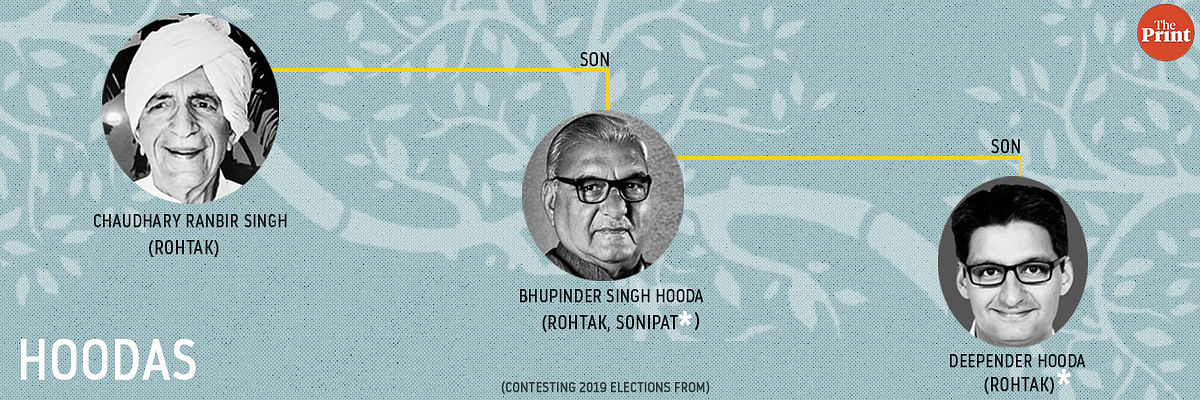
Bhupinder captured the family’s seat of Rohtak in 1991 and held onto it till 2005. The 1991 election victory came after the family stayed out of the poll battlefield for nearly a decade. Bhupinder, however, never managed to secure a central ministry even though he defeated former deputy prime minister Devi Lal thrice from Rohtak.
Bhupinder’s first stint as chief minister came in 2005 when the Congress after initially projecting Bhajan Lal, a non-Jat leader, as its CM candidate switched its choice to Bhupinder, a Jat leader. He was re-elected chief minister in 2009 before the Modi wave brought the BJP to power, for the first time on its own, in 2014.
Bhupinder remains the Congress’ top leader, despite an ongoing struggle with Haryana Congress president Ashok Tanwar, in part due to his proximity to the Gandhis.
“The Hoodas are a family that has been the closest to the Gandhis, especially Sonia Gandhi,” a political analyst who wished to remain anonymous told ThePrint. “As the BJP coalition rose to power in the ’90s, everyone deserted Sonia, expect for Bhupinder Singh Hooda.”
That proximity has brought Hooda under the scanner as, during his tenure as chief minister, the state government allegedly allotted land to Robert Vadra, husband of Congress’ east Uttar Pradesh in-charge Priyanka Gandhi Vadra in the DLF land scam. The case is being investigated by the Enforcement Directorate.
Bhupinder is contesting the Lok Sabha elections from Sonipat.
His son, Deepender Hooda, is the Rohtak MP. Deepender first won the constituency in a bypoll in 2005 when his father gave up the seat to take over as chief minister. He hasn’t lost since and is up for a fourth term on a Congress ticket.
The Chautalas and capture of the Jat vote
Like most of the political families in Haryana, the Chautala clan has its origins in the Congress. It’s senior-most figure, Chaudhary Devi Lal, was a rather late entrant on the political scene compared to Ranbir Singh Hooda but surpassed the latter when he took over as the country’s deputy prime minister for the Janata Dal government from 1989-91.
According to the political analyst quoted above, even though Devi Lal was the glue that held the coalition together, he was passed over for the prime minister’s post since he came across as illiterate.
“Devi Lal was a crucial player in forming the coalition that took power in 1989,” the analyst said. “One of the most interesting things about him was that when he took oath, Lal insisted on saying deputy prime minister despite being told that no such post exists.”
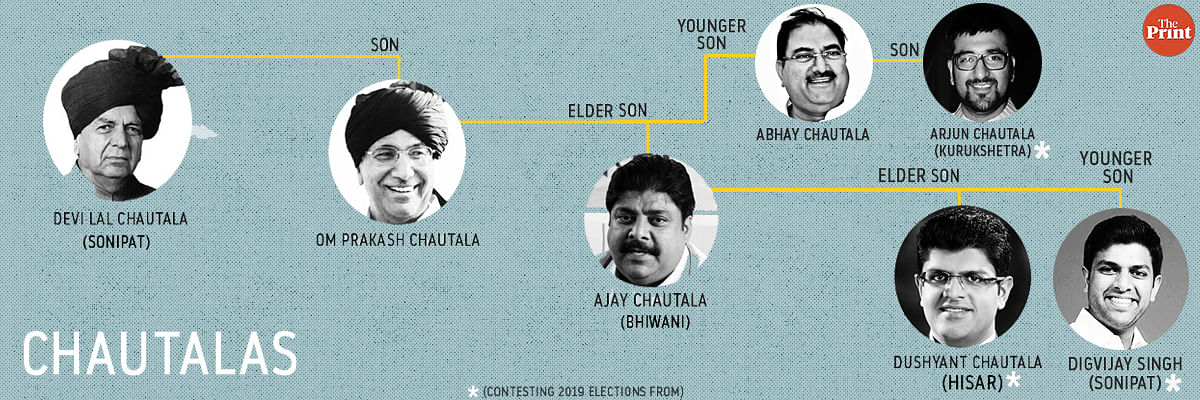
Devi Lal, said professor Anand Kumar, a fellow with Jawaharlal Nehru Museum and Library, funded farmer leaders all the way up to Uttar Pradesh and Bihar and created a galaxy of leaders.
“Haryana was the backbone of anti-Congress politics during the Devi Lal days, that is the ‘70s and the ‘80s,” Kumar said. “The Congress was lukewarm on the issue of Jat reservation. That is what led to the rise of Devi Lal, who seemed the lesser of the two evils soon after the state was formed in 1966.”
Devi Lal founded the Bharatiya Lok Dal, a predecessor of the Indian National Lok Dal (INLD), in 1974. The party name was changed to INLD in 1998.
Lal’s legacy was inherited by his son, Om Prakash Chautala, a five-term Haryana chief minister.
Om Prakash, who heads the INLD, the current principal opposition party in Haryana, had for a while emerged as the foremost Jat leader in the state.
“The Chautalas fashioned a democracy around the dominant caste (the Jats) — they owned land, and were gainers of the Green Revolution, thus, closely linked to peasant movement,” Kumar said.
Of late, however, the Chautalas have been fighting for their political survival, following a high-profile corruption conviction and dissent that has split the family right down the middle.
Chautala and his oldest son, Ajay Chautala, have been jailed after being convicted for alleged corruption in the hiring of Junior Basic Trained (JBT) teachers in Chautala’s fifth term (which began in 1999) as chief minister. Haunted by the scourge of corruption, INLD’s hold in the state steadily began to decline, with the party dropping to just nine seats in the 2005 assembly elections.
They were sentenced to 10 years in jail by the Delhi High Court in 2013, a decision upheld by the Supreme Court two years later.
Fissures in the family began to appear soon after Chautala was jailed — they finally manifested in the split of the INLD in November last year.
The breakaway Jannayak Janata Party (JJP), founded by Dushyant Chautala, Ajay’s son, is contesting the Lok Sabha elections in an alliance with the Aam Aadmi Party (AAP) from Hisar. Dushyant’s brother Digvijay Chautala will be contesting from Sonepat. INLD, on the other hand, will be fielding Arjun Chautala, son of Abhay Chautala, from Kurukshetra.
“The Chautala clan is the pure and simple coming together of caste and cash power,” said Kumar. “Their nepotism is evident, and their suicidal feud is likely to result in their decimation in the state.”
He added that the decline of the Chautala clan is reflective of the busting of the Jat hegemony in Haryana.
“The subtle support for anti-reservation drives, the rise of the significance of BJP and RSS in Haryana, and the proximity to Uttar Pradesh led to the collapse of Jat hegemony, which is perhaps best articulated by the tragedy of (Devi Lal) Chautala’s clan,” Kumar said.
“With the two formations born out of the Devi Lal lineage (JJP and INLD), and the Congress also bending toward Jats with the Hooda lineage, the Jats will have three choices this time,” Kumar added. “This may redefine Jat politics in the state.”
Also read: The Haryana leader who’s uniting anti-Jat forces and could hurt BJP & Congress
Bansi Lal’s Bhiwani
Bansi Lal, who took over as chief minister two years after the state was formed, is popularly referred to as the architect of modern Haryana. Aside from his three stints as chief minister of the state, he was also a close confidante of then prime minister Indira Gandhi and her son Sanjay Gandhi.
“Bansi Lal was one of three people who helped execute one of Sanjay Gandhi’s most controversial schemes — the sterilisation drive that targeted mostly Muslims,” the analyst said.
Bansi Lal held the crucial portfolio of defence at the Centre during Indira Gandhi’s tenure (1975-77). In 1984, he returned as railway minister in the Rajiv Gandhi-led government. He took over as transport minister in 1985 and would continue in the post until 1986. Bansi Lal was a three-term MP from Bhiwani.
In 1996, Bansi Lal parted ways with the Congress to form the Haryana Vikas Party (HVP) and took over as chief minister of Haryana in the same year. His government, supported by the BJP, was toppled in 1999, two years before its term came to an end.
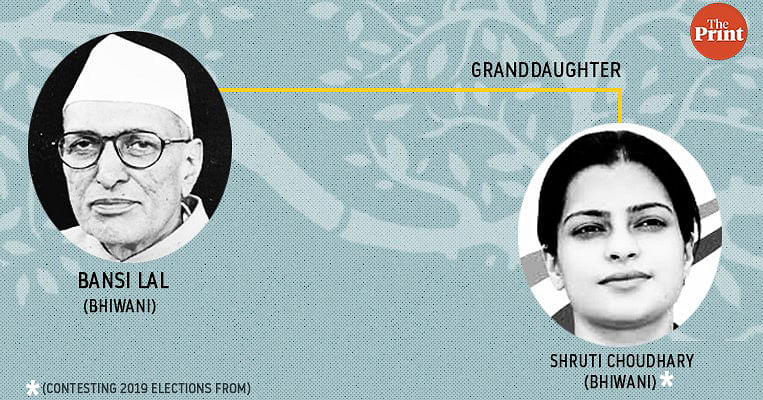
After that, the party struggled to find its footing in the complex political scene and was finally merged with the Congress in 2004.
Bansi Lal is synonymous with a now ubiquitous characteristic of Haryana’s highways.
“Almost three decades ago, Bansi Lal helped set up the first dhaba (roadside restaurant) on a national highway,” the analyst quoted above said. “Now you can’t travel on a highway in Haryana without encountering one.”
Bansi Lal passed away in 2006.
His granddaughter, Shruti Choudhary, contested from his stronghold of Bhiwani in 2009 and won against the INLD’s Ajay Singh Chautala. Choudhary is now contesting on a Congress ticket from the constituency.
Bhajan Lal’s Hisar
Forever associated with the Aaya Ram, Gaya Ram catchline — to denote perennial political turncoats — Bhajan Lal was one of Haryana’s foremost non-Jat leaders.
“Bhajan Lal was the scriptwriter of the ‘Aaya Ram, Gaya Ram’ politics in Haryana,” Kumar told ThePrint. “He challenged Jat hegemony in a cunning way where he used the access to state power as a neutraliser of social power.”
Bhajan Lal began his career with the Congress and first came to prominence in 1970 when he took over as the union minister of state for agriculture (1970-75). Apart from two stints in power at the centre, Bhajan Lal is also a three-term Haryana chief minister.
In 2005, Bhajan Lal was denied the chief minister’s post. Two years later, he joined his son Kuldeep Bishnoi’s Haryana Janhit Congress (HJC).
“After Congress passed over Bhajan Lal for Bhupinder, they offered him governorship,” the analyst said. “Bhajan Lal’s response was simple, ‘only those whose political career is at end become a Governor’.”
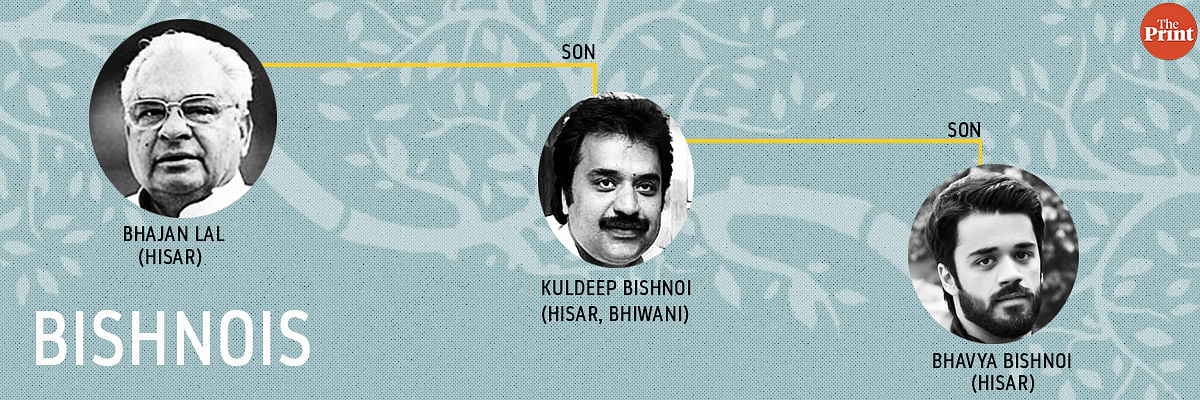
In 2009, Bhajan Lal won the Lok Sabha election from his native Hisar before passing away in 2011. The bypoll for the constituency was won by his son Bishnoi.
Bishnoi’s HJC formed an alliance with the BJP in 2011 but broke it off before the 2014 Assembly elections after accusing the BJP of failing to keep its promises.
In 2016, Bishnoi merged his HJC with the Congress, in effect ensuring his family’s political graph has turned a full circle. Bishnoi’s son, Bhavya Bishnoi, 26, is contesting the Lok Sabha election from Hisar on a Congress ticket.
Bhavya Bishnoi told ThePrint that reconciliation with the Congress came about as all issues raised by the HJC had been addressed.
“All the issues with the Congress have been resolved. My father was opposing the anti-farmer policies of the then Hooda government,” he said. “These have been resolved under Rahul Gandhi’s leadership, and we have returned to our old family.”
Asked if the family’s political demise began with the split from the Congress, Bhavya strongly disagrees. “Not at all. There’s a lot to the story left to be told,” he told ThePrint.
“I am confident that we will do well this election,” Bhavya added.
Analysts, however, believe that just like the Chautalas, this Lok Sabha election is crucial for the Bishnois. “I don’t know if Kuldeep Bishnoi or the new Bishnoi will live up to Bhajan Lal’s legacy,” Kumar said.
Birender Singh and the legacy of a grandfather
The Jat leader who evokes respect from across the community is Chottu Ram, the pre-Independence politician who kept the Congress at bay in what was then undivided Punjab. The founder of the National Unionist Party (NUP), Chottu Ram championed farmer rights.
“Chhotu Ram has always been hailed as the Jaaton ka messiah in Haryana,” the analyst said.
“Chottu Ram’s shadow is shorter than Devi Lal’s but he has been an icon for the whole of Haryana,” Kumar said.
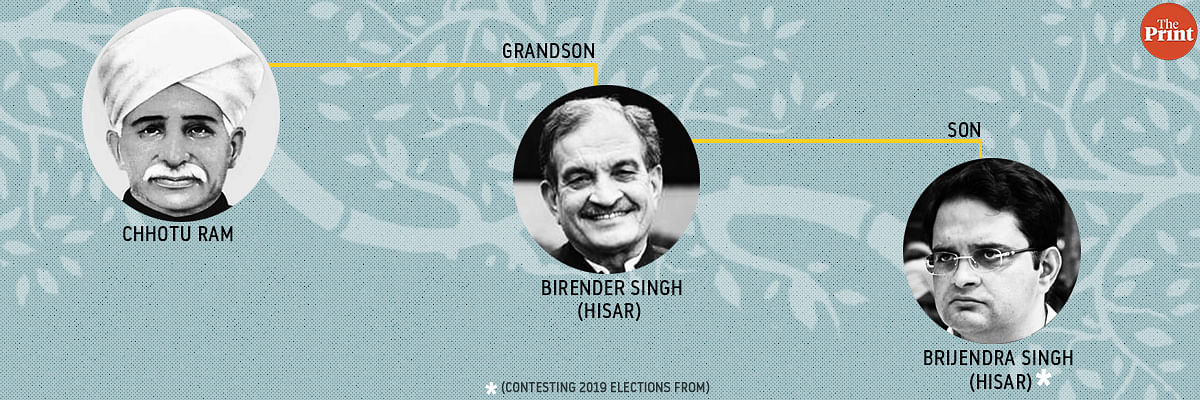
According to Kumar, Ram’s defining politics was his outreach to Muslim agriculturists during the pre-Independence period. “The BJP will have some advantage if they can replicate his model of outreach, to Muslims and other marginalised sections of society, as the monopoly of Jats in Haryana reduces,” Kumar said.
Chottu Ram’s grandson, Birender Singh, is a BJP politician and the Union Steel Minister. But like many others on this list, Singh also began his political career with the Congress. He was associated with the party for over 42 years and even represented Hisar for it in the Lok Sabha (1984-1989).
“Birender had but one dream — he wanted to be the chief minister of Haryana,” the analyst said. “After he was passed over for the post thrice, he couldn’t do anything but quit.”
Singh had joined the BJP ahead of the 2014 Lok Sabha elections in the state.
“Singh, however, bears the ‘dynasty’ mark of a Congress statesman,” the analyst said. “His wife, Prem Lata Singh is a BJP legislator from Kalan, Haryana.”
Singh’s son, Brijendra, is the BJP candidate from Hisar in this Lok Sabha election. The former IAS officer will take on Dushyant Chautala and Bhavya Bishnoi in the constituency.
Also read: Why this Haryana seat could decide fate of more than one Congress leader


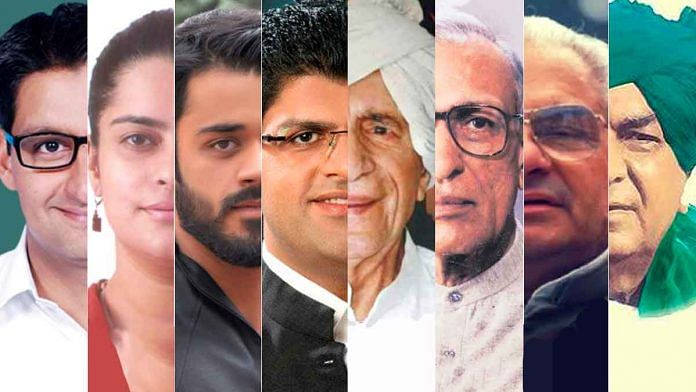

अगली बार से चौधरी देवीलाल और चौधरी बंसीलाल लिखें…..
खास कर चौधरी देवीलाल के नाम के साथ चौटाला न जोड़ें……
वो बहुत महान नेता रहे इंडिया के।
इन्हीं नेताओं के लोकराज में हरयाणा ने सबसे ज्यादा तरक्की की है। जो भाईचारा और सामाजिकता-सामूहिकता इन नेताओं के दौर में रही है उसको छिन्न भिन्न करने में नई सरकार ने कसर नहीं छोड़ी।
Surprised and aghast how come these inefficient, idiot, illiterate and dynast families have fooled the people of a state which is highest in per capita income.
Don’t we find any better person to rule the state. Their qualifications to become a politician is only that they have born in dynast families. Had they born outside then the present ones, even a Panchayat election would have been difficult to be won. Sad but true………… let’s use NOTA against all of these dynast.
डायनेस्टी नहीं कबीलों की वजह से जीतता है कोई व्यक्ति चुनाव… ये सब ट्राइबल लीडर्स हैं और जब तक ट्राइब है तब तक ट्राइब्स के ही लोग लीडर रहेंगे…
जब तक ट्राइबल लीडर है तब तक स्टेट नम्बर एक पर थी, जैसे ही एक पाकिस्तानी शरणार्थी को राज सौंपा, राज्य 6 बार जल चुका है।
Haryana has been a success story, possibly the most productive state bifurcation so far. An early recipient of FDI – a lot of it from Japan – in manufacturing. Its nearness to Delhi has created a boom in real estate, now going through a tough phase. On social indicators, especially the role and status of women, a lot more should be done. The Jat agitation suggests the state needs more investment, jobs, growth. The scions of these five dynasties should give more back to the state in terms of good leadership.